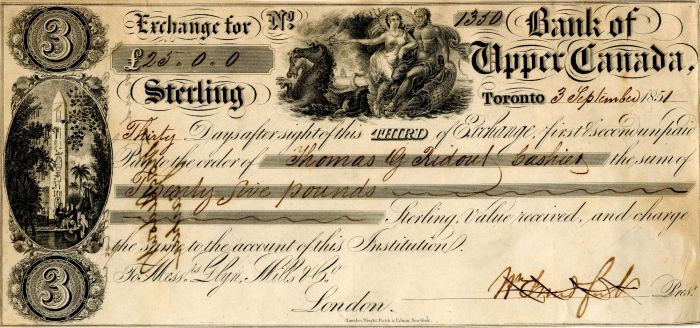Bank of Upper Canada Exchange Draft dated 1851 - Canadian Third Exchange
Inv# FC1005 Check
England
25 Pounds Sterling Exchange Draft mounted to thin card. Rare! The Bank of Upper Canada was established in 1821 under a charter granted by the legislature of Upper Canada in 1819 to a group of Kingston merchants. The charter was appropriated by the more influential Executive Councillors to the Lt. Governor, the Rev. John Strachan and William Allan, and moved to Toronto. The bank was closely associated with the group that came to be known as the Family Compact, and it formed a large part of their wealth. The association with the Family Compact and its underhanded practices made Reformers, including Mackenzie, regard the Bank of Upper Canada as a prop of the government. Complaints about the bank were a staple of Reform agitation in the 1830s because of its monopoly and aggressive legal actions against debtors.
The first Bank of Upper Canada was located on the south-east corner of King and Frederick streets in York, Upper Canada (later Toronto, Canada West). York was then too small for a bank, and its promoters were unable to raise even the minimal 10% of the £200,000 authorized capital required for start-up. The bank succeeded only because its promoters had the political influence to have that minimum reduced by half, and the provincial government subscribed for 2000 of its 8000 shares. The lieutenant-governor appointed four of the bank's fifteen directors, making for a tight bond between the nominally private company and the state. Despite the tight bonds, the Receiver General, the reform-leaning John Henry Dunn, refused to use the bank for government business. Read more at https://en.wikipedia.org/wiki/Bank_of_Upper_Canada









Ebay ID: labarre_galleries